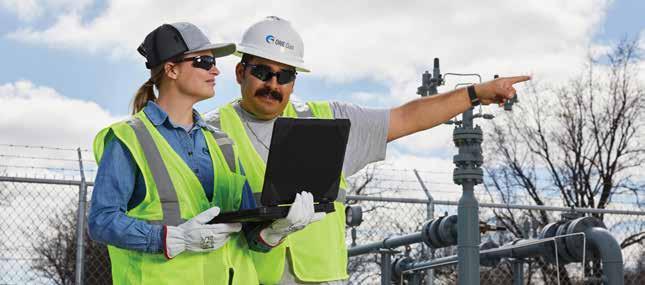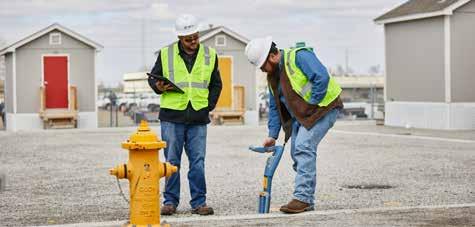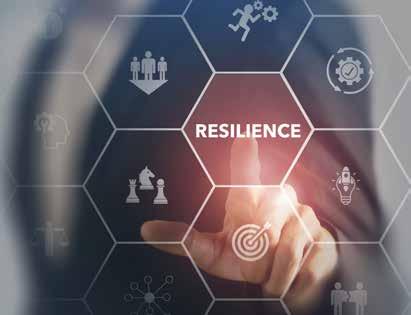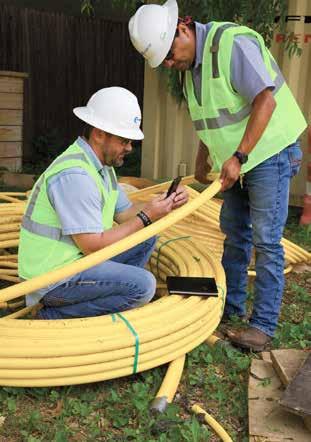
13 minute read
Act Learn Identify
by ONE Gas
Learning Event Protocol
A learning event review aims to understand what led to a safety incident. Learning events explore the systems and processes in place to prevent accidents, helping employees better understand work as performed versus work as planned. This approach supports our focus on “what failed” versus “who failed,” leading to better outcomes for our organization and employees. Successful learning events support a narrative inclusive of multiple perspectives at all levels of the organization. Learning events follow this framework:
• Act – We have opportunities to act when something does occur. This should be an opportunity to learn, as we can continuously improve our systems and processes.
• Identify – Based on the initial investigation and review, we identify opportunities to correct or enhance our safety protocols in some capacity.

• Learn – We prioritize any actionable items and feedback to improve our performance with people, systems and processes. There are opportunities to share this across the organization.
Work When Safe Newsletter
Leaders share a weekly safety newsletter that identifies safety- and health-related topics, practices and procedures. Frontline managers and supervisors deliver this message to their respective employees. The newsletter is also available on our intranet so all employees can comment and offer their perspectives.
Training and Development
Comprehensive Training
All employees receive annual training on our Code of Conduct; cyber and physical security; environmental, safety and health (ESH) compliance; discrimination and harassment prevention; conflicts of interest; and records disposition. All employees who may handle personal health information receive HIPAA training, and our Operations employees engage in a variety of safety and emergency preparedness training on an annual or more frequent basis, in addition to periodic training related to operator qualification. On average, we spend approximately $400 per year per employee on training.
State-of-the-Art Training Center
In June 2021, ONE Gas opened a 17,000-square-foot specialized training center to provide hands-on training to our field service employees. In 2022, more than 23,000 training hours were logged for customer service, construction and maintenance training.

Simulation City
Coming in 2023:
• Increased number of training sessions
• Beginning construction on a similar training facility in Austin, Texas
Our training center includes eight buildings that replicate the real-world scenarios our field workers typically face. Hands-on training lets employees experience utility locating, simulated leaks and addressing code violations. The training center also includes an inspector school, a fire school and a dig site for teaching safe digging techniques, best practices for trench shoring and handling emergencies.
Operator Qualification
Federal law requires operators of energy pipelines to have an Operator Qualification (OQ) Plan and Program to reduce human error and protect life and property. ONE Gas has a comprehensive OQ plan that defines the requirements and processes used to qualify individuals who perform covered tasks on ONE Gas’ pipeline system. Training for our field workforce aligns with B31Q, the industry safety and integrity standard published by the American Society of Mechanical Engineers. Our comprehensive operating standards can be accessed electronically by employees and contractors performing work on our system.
Methods and Practices
Qualifications – Individuals must be appropriately qualified to perform covered tasks or, for non-restricted tasks, be directed and observed by a qualified individual.
Our Employees – ONE Gas directly supervises and verifies OQ for its employees to help ensure quality training.
Our Contractors – A third party administers OQ assessments and maintains OQ records for contractors to ensure that all work on our system is done by trained personnel. Verification – OQ records are accessible to inspectors via an e-wallet certification, which all individuals performing covered tasks are required to carry, allowing us to verify credentials quickly.
Safe Work – Work is not allowed to begin on a job site until a safety review has been completed and the inspector has verified that the individuals at the job site are either qualified to perform the covered tasks or, where appropriate, will be directed and observed by a qualified individual.
Contractor Safety
Contractors play an important role in providing safe, reliable service to our customers, performing construction work, customer service and compliance activities. ONE Gas evaluates contractor safety through consistent communications and inspection. Our sourcing practices include utilizing a third-party service to vet potential contractors’ safety performance, policies and practices to confirm they meet our requirements before performing work.
AGA Peer Review
ONE Gas actively participates in the AGA’s Voluntary Peer Review Program. During a weeklong, in-depth review in 2022, peer reviewers observed our damage prevention and construction contractor relationships. At the end of the week, reviewers identified potential areas for improvement.
ONE Gas is an Active Member of Many Industry Organizations
Operational Safety and Emergency Preparedness
We use various technologies to monitor and maintain our natural gas distribution system to allow the safe delivery of natural gas to our customers and the communities we serve. These safety procedures and technologies are important parts of our system integrity program that help identify areas of improvement as we continue to modernize our system.
Pipeline Safety Compliance
We continually monitor safety performance through this system even after onboarding of contractors and proactively address concerns through our dedicated contractor performance team.

We continue to stress the importance of safety to our contractors. Our contracts require safe practices in accordance with regulatory requirements and standards governing the work they perform. In addition to the frequent interactions between our contractor performance team and contractors, annual Contractor Safety Summits are another way to make contractors aware of safe digging and other safety practices. Contractors from across our service territory meet with representatives from ONE Gas to share safety best practices and review new protocols and procedures.
Collaborating with peers to highlight leading practices and identifying opportunities for improvement reinforces our commitment to safety while driving a culture of innovation, resiliency and continuous improvement.
Our Pipeline Safety Compliance program supports the company’s commitment to safety by implementing a framework and processes to achieve regulatory compliance. Our dedicated Pipeline Safety Compliance group works alongside our Operations team to drive compliance, and continuous improvement across the organization.
Emergency Valve Corridor Project
Since 2020, we have been enhancing our emergency valve systems to improve reliability by limiting the impact of outages on our customers when a line needs to be shut off. Engineering and Operations utilize modeling software and a sectionalized boundary grid system to continually upgrade the pipeline system and optimize shutoff valve locations in system planning.
We continue to execute the OSMS, work with contractors to help them integrate OSMS principles and make improvements as needed.


We use the four-step cycle to determine
1) what we need to do,
2) how to execute the work,
3) how to review what we did, and
4) how to improve.
10 Elements of the ONE Gas Safety Management System
Safety Management System
ONE Gas operates using a comprehensive and systematic approach to managing safety called the ONE Gas Safety Management System (OSMS). This safety management system aligns with API Recommended Practice (RP) 1173 for pipeline safety, which utilizes a PlanDo-Check-Act cycle to foster continuous improvement. In mid-2019, the AGA board asked member companies to implement API RP-1173 voluntarily within three years. ONE Gas was an enthusiastic supporter of this, and has met this industry wide commitment.
These four steps provide an ongoing process to identify improvement opportunities. Our Environment, Safety, Health and Compliance (ESH&C) steering committee, which our chief operating officer chairs, is responsible for providing direction and oversight of the OSMS process throughout the organization.
API RP-1173 2022 Highlights
• Completed our second maturity assessment to identify potential opportunities for improvement with increased ratings from the 2020 assessment.
• Conducted 80 meetings with 68 stakeholders across various corporate and divisional workgroups to understand existing controls and performance related to each requirement of API RP-1173.
• Assigned an overall rating for each of the 10 elements of the Recommended Practice.
• Used data to identify potential opportunities for improvement related to API RP-1173.
• Conducted our first safety culture survey.
Business Continuity Plan and General Emergency Preparedness

ONE Gas has a full complement of emergency and crisis plans, assessments and committees designed to mitigate risk and promote emergency preparedness for pipeline operations and cybersecurity. Each operating division performs emergency drills at least annually and includes local emergency management personnel and public authorities.
Company officers and management regularly discuss areas of improvement and industry examples of natural gas emergencies and responses. All departments must create, maintain and periodically review and update business continuity plans.
We also participate in emergency drills hosted by various thirdparty community partners, agencies and organizations.

Crisis planning guidance documents include:
• Pipeline Emergency Response Plan
• Threat and Hazard Identification and Risk Assessment
• Crisis Management Plan
• Business Continuity Plans
• Cybersecurity Corporate Security Plan
• Cybersecurity Incident Response Plan
Emergency Response Time (ERT)
We closely monitor the time between creating an emergency order and the arrival of the first company responder to the scene.
In 2022, our average response time for natural gas emergencies was 28.4 minutes. That includes responding in urban, suburban and rural areas across Kansas, Oklahoma and Texas.
Our Field Operations leadership reviews and evaluates ERT performance monthly to determine how we can further improve and execute on opportunities they identify.

System Resiliency
We continue to increase and support the reliability and resiliency of our system by investing in system integrity and pipeline supply reinforcements, creating redundancies within our system. We experienced no significant outages during Winter Storm Elliott in late 2022. In recent years, we have focused on improving the resilience of our system to be better prepared for events like Winter Storm Uri in 2021. Since ONE Gas became an independent company in 2014, we have completed 22 projects that provided new transmission and distribution supply points and 127 interconnections, reinforcement or regulation projects to strengthen our system.
Cyber and Physical Security
Our company’s focus on safety extends to protecting our physical security, information technology and operational technology assets.
Our chief information officer (CIO) reports directly to the CEO and leads ONE Gas’ cyber and physical security efforts. The CIO attends regular meetings of the ONE Gas Board of Directors to provide updates on the cybersecurity landscape and what we are doing to keep our customers, employees and systems safe. Under the CIO’s direction, the ONE Gas cyber and physical security teams operate 24/7, continuously analyzing our business’s cyber and physical security risks.
We address cyber and physical security risks through multiple layers of prevention: Our Company
• Implements multiple layers of security technology, including AI-assisted surveillance and intrusion detection
• Exchanges information with peer companies to improve security across our industry
• Voluntarily participates in Transportation Security Administration (TSA) corporate and critical facility security review programs
• Routinely engages third-party experts to assess the company's cybersecurity posture and controls
• Works collaboratively with TSA on mandatory security directives issued to pipeline operators in 2021, Security Directives Pipeline-2021-01 and Pipeline-2021-02
Our Cyber and Physical Security Teams
• Perform continuous monitoring of ONE Gas systems and facilities for cyber and physical security risks
• Routinely conduct cyber and physical security drills and training
• Security Operations Center (SOC) is staffed by security personnel 24/7
Our Technology and Data Compliance Team
• Led by our CIO, the Security and Information Technology Governance Committee is a cross-functional governance committee responsible for overseeing the company’s security and compliance-related strategies, risks and operational initiatives
• Creates and executes the annual Cybersecurity Assessment Program and other compliance reviews in support of TSA’s Security Directives
• Coordinates the maintenance and compliance review of System Security Plans in support of Department of Defense federal contract acquisition regulations for technology and cybersecurity
Our Employees
• Complete quarterly, mandatory cyber and physical security awareness training
• Participate in monthly phishing awareness exercises
• Are provided with a phone number to report any suspicious activity connected to our assets or facilities
• Are trained in how to handle sensitive or confidential information, including HIPAA training, as appropriate to their roles
Privacy Practices and Protection
It is necessary for ONE Gas and some of its vendors and contractors to collect personal information about our customers to provide natural gas service. We take our obligation to protect this information seriously and have several protocols to safeguard customer information:
• We annually assess key components of our IT infrastructure as part of our Sarbanes-Oxley compliance review
• We annually assess key components of our IT systems as part of our cybersecurity compliance review

• We encrypt sensitive data end-to-end in transit and while it is stored online and on backups
• We utilize technology and controls to reduce the risk of cybersecurity breaches
• Vendors with access to customer information are contractually obligated to employ adequate data security practices and protocols to protect ONE Gas information, including providing periodic SOC 2* reports and other information about their security credentials and practices
• We do not sell our customers’ personal information to third-party companies
• The websites for each of our divisions provide customers’ data usage and privacy terms and conditions
For the year ending December 31, 2022, there were no disruptions to our business caused by a cyber incident or data breach. We remain constantly alert to keep our systems secure and remind our employees to be vigilant.
*A SOC 2 report is designed to assure relevant entities about the suitability and effectiveness of an organization's controls relevant to security, availability, processing integrity, confidentiality and privacy.
Risk Assessment and Damage Reduction
Common Ground Alliance
ONE Gas is a member of the Common Ground Alliance, a forum that allows stakeholders to collaborate, share best practices and promote effective damage prevention practices.
System Integrity
We leverage data in all areas of our pipeline safety program to guide decision-making and improve our processes. Analyzing data on pipeline damage and reportable incidents, understanding what the data tells us and taking action to reduce such incidents enhances safety for all stakeholders and helps reduce accidental methane emissions. Over the years, we have built several systems to improve our processes and drive down these numbers.
Pressure Reduction Project
Operating our transmission pipelines at lower pressures significantly increases safety by reducing the risk of a pipeline rupture.
Through a series of projects, we have lowered pressures on certain high-pressure pipelines in metropolitan areas. Over the last 14 years, we have reduced pressure on more than 1,400 miles of transmission pipelines.
Data-driven Approach to Damage Prevention
ONE Gas utilizes a Damage Information Management System, a centralized process and system of record for documenting damage to ONE Gas natural gas pipelines and facilities. The company can determine common causes of damage and use that information to improve our prevention and public awareness outreach and reduce future pipeline damage.
Ticket Management System
Before digging or excavation activity, the law requires that a person or company call their local One Call Center (typically by dialing 811) so that local utilities can locate and mark any underground lines in the area to prevent damage.
ONE Gas uses a cloud-based ticket management system to intake and distribute excavation ticket requests from the One Call Centers in the states we serve. Tickets are routed through a centralized platform and immediately passed to the line locator, which gives ONE Gas increased visibility into ticket data and line location performance. These insights allow ONE Gas to manage line locating more effectively and target improvement efforts as needed to avoid damage to our pipelines.
ONE Gas utilizes Risk Assessment and Damage Reduction technology, also known as RADAR, to pull data from public and internal sources. This application, developed by ONE Gas Information Technology, System Integrity and Field Operations team members, helps us analyze data and prioritize the probability of damage occurring due to excavation activities near our pipelines. As higherrisk situations are identified, we can proactively connect with the excavator on-site before the excavation begins to foster safe practices. We have started using RADAR in major metro areas in Kansas and Oklahoma, begun implementation in Texas, and plan to expand deployment to more locations over the next few years. The implementation of RADAR is an excellent example of continual efforts to improve our safety performance and reduce emissions.
Public Awareness Efforts
Our public awareness efforts and damage prevention programs proactively engage key audiences and provide information to help our stakeholders make informed and safe decisions and avoid damage to our pipelines.
Public Awareness Programs Include:
• 811 Call Before You Dig – Participate in local damage prevention programs to promote safe digging

• Natural Gas Safety – Educate the public about how to detect a natural gas leak and what to do and not do if they suspect one
• Cross bore Education – Provide cross bore awareness and safety measures to plumbing and excavating stakeholders (cross boring occurs when a natural gas line intersects another utility’s line)
• Social and Traditional Media – Leverage popular social media platforms and news media channels to raise awareness of safe digging
• Employee Engagement – Create safe digging employee advocates through educational materials, contests and trivia
Key Audiences Include:
• Customers
• Emergency responders
• Professional excavators

• Homeowners
• Employees RADAR is an application developed by ONE Gas that monitors the location of excavation activities near pipelines.
• Public officials
Material Tracking and Traceability
We currently utilize a material tracking and traceability mobile application to install new transmission facilities. Knowing the pipe location, material and installation date of our pipelines helps us plan system upgrades and replace pipes as needed. A quick barcode scan on the pipe captures essential data such as the type of material, time and location where it was made. We plan to utilize this application for our distribution assets starting in 2023.
Advanced Leak Detection Technology
We regularly conduct leak surveys on our gas delivery system to find and address leaks.

ONE Gas utilizes advanced mobile methane leak detection units where mobile units are mounted within vehicles to provide in-depth analysis and create reports showing potential infrastructure leak locations. Potential leaks are then investigated and repaired according to their classification. Our units are deployed in some operating areas in Oklahoma and Texas, and we’re working alongside the Kansas Corporation Commission to implement the technology in Kansas.
The advantages of advanced mobile detection include electronic data collection and analytics, the ability to operate in adverse weather conditions and the potential to survey approximately two times faster.

PIPES Act of 2020
ONE Gas is subject to and has fulfilled the requirements of the Protecting Our Infrastructure of Pipelines and Enhancing Safety (PIPES) Act of 2020, Section 114. The PIPES Act requires operators to review and update their Operations and Maintenance manuals to verify that the plans contribute to public safety. They are designed to respond to hazardous leaks, reduce the release of natural gas from pipelines and protect the environment.




